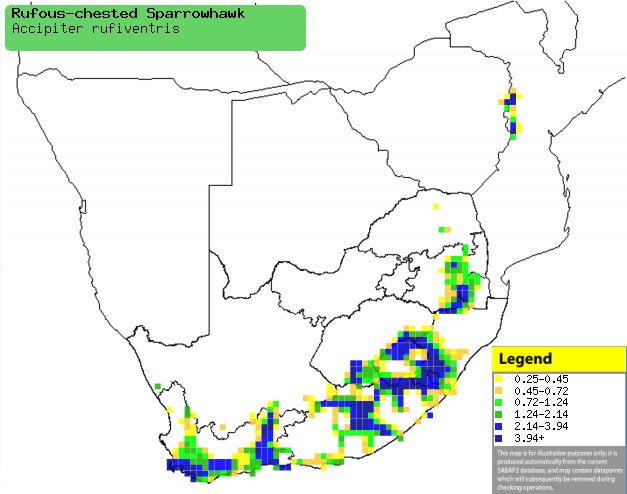|
Accipiter rufiventris
(Rufous-chested sparrowhawk, Red-breasted sparrowhawk)
Rooiborssperwer [Afrikaans]; Ukhetshana (also applied to
Little sparrowhawk) [Xhosa]; Kakodi (generic term for sparrowhawks,
goshawks, kestrels and falcons) [Kwangali]; Phakoana (generic term for
small bird-of-prey?) [South Sotho]; Rukodzi (generic name for a small
raptor such as falcon or sparrowhawk) [Shona]; Phakalane, Segôôtsane
(generic terms for some of the smaller raptors) [Tswana]; Afrikaanse
sperwer [Dutch]; Épervier menu [French]; Rotbauchsperber [German];
Gavião-ruivo [Portuguese]
Life
> Eukaryotes >
Opisthokonta
> Metazoa (animals) >
Bilateria >
Deuterostomia > Chordata >
Craniata > Vertebrata (vertebrates) > Gnathostomata (jawed
vertebrates) > Teleostomi (teleost fish) > Osteichthyes (bony fish) > Class:
Sarcopterygii (lobe-finned
fish) > Stegocephalia (terrestrial
vertebrates) > Tetrapoda
(four-legged vertebrates) > Reptiliomorpha > Amniota >
Reptilia (reptiles) >
Romeriida > Diapsida > Archosauromorpha > Archosauria >
Dinosauria
(dinosaurs) > Saurischia > Theropoda (bipedal predatory dinosaurs) >
Coelurosauria > Maniraptora > Aves
(birds) > Order: Falconiformes
> Family: Accipitridae
> Genus: Accipiter
For information about this species, see
www.birdforum.net/opus/Rufous-chested_Sparrowhawk Distribution and habitat
Occurs in isolated patches of sub-Saharan Africa, from
Ethiopia, eastern DRC and Kenya to Uganda, eastern Zambia to South Africa. In
southern Africa, it is scarce to fairly common in Zimbabwe's eastern highlands
and adjacent Mozambique, and mesic areas of South Africa. It generally prefers afromontane forest
or stands of alien trees
in otherwise open habitats, such as fynbos or grassland; it is also adapted to
living in suburbia, such as in Cape Town.
|
 |
|
Distribution of Rufous-chested sparrowhawk in southern Africa,
based on statistical smoothing of the records from first SA Bird Atlas
Project (©
Animal Demography unit, University of
Cape Town; smoothing by Birgit Erni and Francesca Little). Colours range
from dark blue (most common) through to yellow (least common).
See here for the latest distribution
from the SABAP2. |
Movements and migrations
Resident and largely sedentary, although it may
disperse from its territory after breeding.
Food
It almost exclusively eats small birds, typically hunting by
soaring across the sky then stooping and pursuing its prey. It also can hunt from
a concealed position in the tree canopy. In fynbos, it often uses stealthy
tactics, flying very close to the ground under cover, before ambushing its prey. The following food items have been recorded
in its diet:
Breeding
- Monogamous, territorial solitary nester, performing a display in which the
pair fly synchronously in an undulating flight.
- The nest is mainly built by the female in about 22-59 days, consisting
of a saucer-shaped platform of sticks which is sometimes lined with lichen,
bark, moss or pine needles. It is typically placed in the canopy of an alien
tree, such as Eucalyptus or poplar (Populus), or it may
alternatively use an indigenous tree such as a yellowwood (Podocarpus).
- Egg-laying season is from is from August-December, peaking from
September-October.
- It lays 2-4 eggs, which are incubated almost solely by the female, while
the male feeds her regularly at the nest.
- The chicks are brooded and cared for by the female for the first 25 days
of their lives, while the male delivers plucked and decapitated birds for
her and the young to feed on. The female then starts to help the male
provision food for the chicks, who leave the nest at about 29-40 days old,
becoming fully independent roughly 17-47 days later.
Threats
Not threatened, in fact its range has increased due to the
introduction of alien trees, which it uses for nesting in otherwise open areas,
References
-
Hockey PAR, Dean WRJ and Ryan PG 2005. Roberts
- Birds of southern Africa, VIIth ed. The Trustees of the John Voelcker
Bird Book Fund, Cape Town.
|
